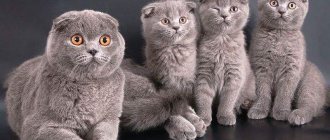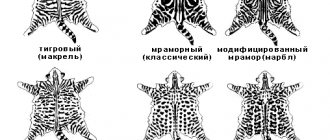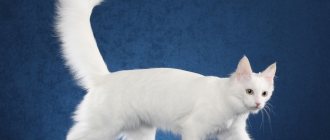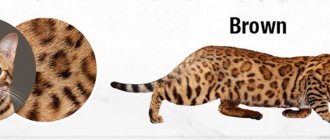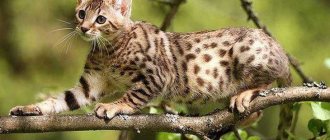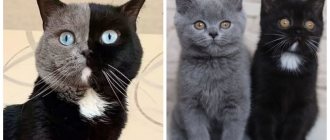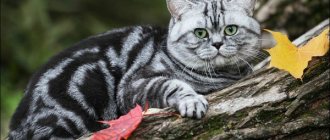Scottish Blue Point cats
The color of blue point Scottish cats (translated from English as “blue-point” means “blue dot”) is very beautiful. These are completely unique shades of light fur - the main color and shading on the paws, muzzle, ears and tail. Many people want to get just such a cat, because she is fabulously cute.
In the photo: Scottish Fold Blue Point
In the photo: Scottish Straight blue point color
The blue point color is associated with the phenomenon of acromelanism - the dependence of the intensity of coat coloring on temperature: in places where the body temperature is higher, the coat is lighter, and vice versa. While colorful kittens are in the mother’s belly, they are completely light, because their body temperature is uniform. But within a few days after birth, Scottish Blue Point kittens begin to darken their paws, tail, face and ears due to the fact that the temperature of these parts of the body is lower than the rest. This effect is associated with the action of the enzyme tyrosinase, which is responsible for the synthesis of pigments. By the way, for the same reason, colorful cats can change color slightly depending on the air temperature - sometimes darker, sometimes lighter. In addition, this color changes with age.
The color gene in cats determines not only the color of the coat, but also the eyes, which remain blue without changing to golden in adulthood. Blue eyes are the dream of almost every cat owner. And the main thing is that in this case the blue-eyed gene is not associated with deafness, as happens in pure white murkies. As a result, we have unique shades of eyes and fur, which, as a rule, are liked by absolutely everyone, even those who can’t stand Chocleate Point cats (“chocolate point”), which are associated with Siamese and create the impression that they stuck their muzzle in chocolate.
What does genetics have to do with it?
Many people are probably wondering: how did it happen that all the representatives of this group are colored so uniquely? To answer this question, you will have to go back many decades and remember that cats became the object of attention of specialists in the second half of the 19th century. The British then began to perceive them as purebred animals and specially breed certain species.
The color point color is found in cats such as Ragamuffin, Highland Fold, Balinese, Siberian and American Shorthair.
The Siamese and Persian cats marked the beginning of the official registration of cat breeds. Later they became the progenitors of many modern cat breeds, including color points. Siamese cats came to Europe in 1870 and became favorites of many families. Blue eyes and unusual coloring are what attracted me in the first place.
Some scientific facts.
The color of the coat and eyes depends on a polymer pigment called melanin. It is formed from the amino acid tyrosine under the influence of the enzyme tyrosinase. It is this enzyme that is controlled by the gene that determines color, which is called Color. This gene is designated by the letter “C”. When the C gene is mutated, no active tyrosinase is produced and the pigment does not appear. In this case, the cat is born an albino, that is, uncolored. And the mutated gene is already indicated by the small letter “c”.
Where did these black spots come from then?
Scientists have discovered the Himalayan cs, or ch gene, which is also formed from a mutated C gene. But in this case, the enzyme tyrosinase becomes heat-sensitive, that is, depending on the temperature, it changes its activity: at high temperatures, tyrosinase is inactive, and as soon as the temperature drops, melanin in the cells it begins to produce and color the cooled areas of fur in darker colors. This is how the Siamese color turns out, which, by the way, is found not only in cats. In the last 30–40 years, geneticists have developed a large number of breeds that differ in color point color.
Blue point color standard
A straight-eared or fold-eared Blue Point Scottish cat should have a blue mask on its face and the same markings on its ears, paws and tail. The rest of the body is almost white: without markings or patterns, blurred spots and yellow tones. All this is considered a disadvantage.
A good point color that will last a lifetime is quite difficult to obtain. Small kittens often have high-quality coloring that matches the standard, but as they grow older, the body may darken, which is a big disadvantage.
The ideal point color works well when both parents of the kitten are also points, and not in the first generation. Conversely, there is a greater chance of getting a darkened body if the parents were of a different color, for example, solid (solid).
The eyes of a blue point cat, as we have already said, are blue. The darker, more saturated, “deeper” the color, the better. Cats with light eyes (and often they are not at all expressed, grayish) are valued less.
Colories with decent eye color often have disgusting coat texture and a rustic appearance. The British often have weak bones, the Scots have short, problematic tails and ears that are not laid back well enough. These disadvantages are related to similar problems with shaded colors, which are most often used to produce color points. Yes, there are already some British people with decent hair and decent type, but there are only a few of them. As well as in the colorful colors worthy of the Scottish ones, there are only a few. British colors, obtained from blue, lilac, and patterned animals, most often have good bone and coat. In some places there is even a good contrast, but for the most part they have an extremely pale eye color. Scottish breeds bred from colored stock are also pale-eyed. They have a positive chance only if they are obtained from stable lines imported at different times from the USA and Canada. Local stock bred from the British will produce British-like variants with all the characteristic nuances.
International system of classification of colors and other external characteristics of Scottish cats
An important factor when choosing a Scottish kitten is its color. However, it is worth considering that the pattern on the fur will become relatively clear and understandable by the age of 3 months of the animal’s life. But you can accurately determine the color only by 6-7 months! It often happens that certain marks on a kitten's fur disappear as it grows. The price of a cat is primarily influenced by color, more details in this article.
In the world, it is customary to divide cats by color according to the international classification system (WCF).
The color code looks like this: xx.NN.NN.NN. (NN), namely:
| x | NN. | ||||||
| (can combine 2 signs - xx) | (can combine up to three pairs of signs (NN.), the fourth (NN) is additional | ||||||
| first digit “0” of the code (presence of white color) | first digit “1” of the code (presence of tipping) | the first digit of the code is “2” (presence of tabi color) | the first digit of the code is “3” (presence of point color) | the first digit of the code is “5” (tail length) | the first digit of the code is “6” (eye color) | the first digit of the code is “7” (ear placement) | |
| a – blue - blue | 01 –van-van | 11 — shaded (the hair is darkened in the upper part by 25%) | 21 - tabby, agouty - striping, agouti factor | 31 — Burmese color | 51 – rumpy – tailless (Manx breed) | 61 - blue | 71 - straight ears - straight ears or “straight” |
| b - chocolate (brown, chestnut) - chocolate, chestnut, brown, Havana | 02 - harlequin | 12 - tipped, shel - veiled (the hair is darkened in the upper part by 12.5%) | 22 - blotched, marble - marble | 32 - tonkinese color - Tonkinese | 52 -rumpy riser - tail with 1-2 vertebrae (bob-tail) | 62 – yellow, golden – golden, yellow, red | 72 – curled ears – ears curled back or “curl” |
| c –l ilac(lavender) – lilac, lavender, platinum | 03 - bicolour-two-color, bicolor | 23 - mackerel, tiger - tiger | 33 – Himalayan(siam) color – Himalayan (Siamese) | 53 – stumpy – tail from 7 to 13 cm when curled | 63 - oddeyed - odd-eyed | 73 – folded ears – ears curled forward or “fold” | |
| d - red, flame - red | 04 - mitted/white point - with white markings (color-points) | 24 – spotted – spotting | 34 - singapura color - Singaporean | 54 - longy - normal long tail | 64 - green - green | ||
| e - cream - creamy | 05 - snowshoe -snow-shu | 25 – ticked | 35 - abyssinian color - Abyssinian | 65 – Burmese – eye color in Burmes cats | |||
| f – tortoiseshell - tortoiseshell | 09 – little white spots – individual white spots (“collar”, “socks”) | 66 – tonkinese – eye color in Tonkinese cats | |||||
| g- blue – cream - blue cream, blue tortoiseshell | 67 – Himalayan or siam – eye color in Himalayan (Siamese) cats | ||||||
| h - chocolate-tortie - chocolate tortoiseshell | |||||||
| j - lilac-tortie-lilac tortoiseshell, lavender tortoiseshell | |||||||
| n - black, ebony, seal, sable, ruddy - black, seal, sable, wild | |||||||
| o - sorrel, cinnamon, honey - sorrel, brown, red-brown, honey | |||||||
| p - beige fawn - yellow-brown | |||||||
| q – sorrel tortie – red-brown tortoiseshell | |||||||
| r - beige fawn tortie - yellow-brown tortoiseshell | |||||||
| s - silver, smoke - silver, smoky | |||||||
| w - white - white | |||||||
| y - golden | |||||||
| x - unregistered - unrecognized color without registration | |||||||
For example, the color code “red bicolor tabby (tabby)” would look like this: d0321.
Red spotted tabby bicolor – d2403
▲ to contents
Blue point color genetics
Point belongs to the black series of colors, because, from the point of view of genetics, blue is nothing more than a diluted, or rather rearranged, black pigment. But blue coat genes B (black series) and d (dilution gene) alone are not enough to get a point kitten. A couple more recessive cs genes are needed, which displace the pigment into the marking area.
The ancestors of the Points are Siamese cats, which is why the color is also called Siamese. In Thailand it is considered sacred because... he was taken out by the monks in the monastery.
Today, among Scottish cats, the color gene cannot be called so rare, but breeders often value its carriers higher than solid blue cats. There are even entire nurseries that specialize in the reproduction of Point cats.
You can get a point cat even if both parents, for example, are gray (that’s what people call them, although they are actually blue). The main thing is that they are carriers of the desired gene. But even if they carry this gene, the chance of having a colored kitten is 25%. It happens that the color gene appears after 2-3 generations. For example, the kitten’s great-grandparents were colorful, but the gene did not manifest itself in the form of color in the parents. At the same time, two color point parents cannot produce a kitten of a color other than color point.
The international designation for the blue point color is a33.
Features of mating British blue point dogs
The bluepoint color is quite difficult to breed, since the cs gene is recessive (suppressed). Only when both producers (male and female) have such pigment colors, the kittens in the litter will be guaranteed to be pointing only. Parents with smooth, monochromatic hair who are carriers of the cs gene can also produce children with Siamese pigmentation, but with a 25% chance. If a Blue Point female or male is bred with a carrier of the gene, half of the kittens are born white and then acquire the characteristic blue markings.
Source
Strabismus in point cats
Cats of any point color (and there are not only blue, but also seal point, lilac point, lynx point and other variations) can experience convergent strabismus, which is characteristic of cats of the Siamese, Thai, Oriental and Burmese breeds. This defect, geneticists believe, is a byproduct of the action of the cs point gene.
Often in point cats you can find a violation of the projection of the optic nerves: part of the visual pathways from the eye goes to the side of the brain opposite to the norm. To compensate for this feature, strabismus appears, which allows the cat to build the correct visual picture.
However, there is an opinion that just one pair of cscs genes is not enough for the development of strabismus: additional genes are needed that lead to such a disorder. That is, to say that most point cats suffer from strabismus is incorrect: the majority of Scots point cats, in fact, do not have this problem.
Point color of Scottish cats: photo, description, care
Colors of color-point Scottish cats, Scottish color cat: varieties, photos, genetics, features of maintenance and character.
The color point color (or color point, which in translation from English means “colored dot (mark)”) is found in many breeds of cats: it can be possessed by a Scottish and British cat, a Persian cat, a Neva Masquerade cat, a Thai cat, a Snowshoe cat, sacred Burmese, Siamese and others. Due to the fact that this color was originally developed by the monks of Thailand, it is also called Siamese or Himalayan. In Thailand, Siamese cats are considered sacred. That is, if someone says “Scottish Straight or Siamese Fold kittens,” this means that we are talking about color points.
A color-point cat or cat has a colored muzzle, ears, paws and tail, while the rest of the body remains light. The nose and paw pads are the main color, i.e. the one in which the marks are painted.
Depending on the color of the markings, there are a large number of point color varieties. Let's talk about the main ones.
Blue Point (a33): blue (gray) markings on an almost white body with a bluish tint, yellowish tints to the body are considered a fault, paw pads and nose are gray. Cream Blue Point: Cream markings on a darkened creamy white body, nose either pink or dark.
That is, if a Scottish Fold cat has a color point color, you need to specify which one: blue, seal, choclit, etc., because point is a whole group.
This color is formed thanks to a pair of cs genes and other additional genes. It is temperature dependent, because points appear in those places on the body that have a lower temperature. Also, the color becomes darker or lighter depending on the ambient temperature. Color point kittens are always born completely light, because... the temperature in the womb warms them up evenly: only after a few days does the true color begin to appear, when the paws, ears, muzzle and tail acquire a lower temperature than the rest of the body.
Color point is a complex color, the genetics of which have not yet been fully studied. It is difficult to get a good Scottish or British cat in a high-quality point color. As practice shows, points that initially have an ideal, that is, a pronounced contrast between the points (marks) and the rest of the color, have a greater chance of subsequently darkening throughout the body. At the same time, points with insufficient contrast are valued less.
Blue point color and character
There is an opinion (not a proven fact) that the Blue Point Scotsman is a cat with character. The fact is that the blue colors of the Scots were originally obtained from British cats, known for their temper. Modern Scottish Folds and Blue Point Scottish Straights are somewhat similar in character to the British: they are independent, willful, and can be aggressive if they don’t like something. However, the degree of expression of these qualities depends on the presence of British cats in the immediate family. If there are a lot of British people in the document, you should expect a tougher character, and vice versa. However, British genes will still be softened by Scottish ones, so such cats are more sociable and kinder than their British counterparts.
Caring for point cats
In general, care for point cats is the same as for cats of other colors. But it has its own characteristics.
Point cats cannot be cut or shaved: this leads to the appearance of darker areas of the coat. In the photo below you see the “panties” of a point cat, which formed after shaving before sterilization. This feature of this color, of course, does not mean that a Point cat cannot be operated on: a mark on the stomach does not make the animal less beautiful, because it is practically invisible. But, if you trim your cat's entire hair or in prominent places, or shave it, this can cause it to become dark throughout the body, and this will ruin its appearance.
Inept use of a fruminator when combing can also lead to bad consequences, because... With this tool it is easy to damage and cut off hairs, resulting in the undesirable effect of darkening the fur. If you do not know how to use a furminator, it is better to opt for a special paw for combing cats.
Also, the color of the point, as we said above, reacts to the ambient temperature: the lower it is, the darker the marks, and vice versa - in the heat, many cats become significantly lighter. Accordingly, don’t be surprised if your cat looks a little different depending on the time of year. The ideal temperature for keeping points is +25 degrees.
It is worth considering that the blue point color is a light color, and therefore easily soiled: dust and dirt in the house, settling on the fur, will spoil the appearance of the cat. Even if she is washed regularly, you will notice that the color becomes more interesting after a bath. This statement is not a call to endlessly bathe your pet, but advice on how you can improve the color if you suddenly notice that it has worsened. If the cause was contamination, advice will help. Although there are many other reasons for the deterioration of color point colors.
To improve the color, you can bathe Blue Point cats whose bodies are not light enough with special lightening shampoos. However, if the cat’s markings, on the contrary, are weakly expressed, then there is no need to lighten the fur further. Then you can choose any shampoo based on the problem (if any) or a basic one. We are talking about professional shampoos. It is better to avoid mass-market shampoos.
Some owners notice that food also affects the color of Blue Points: beef, carrots, beets, liver and seaweed can darken the coat. However, this has not been scientifically proven, and along with the owners who noticed changes in color depending on the diet, there are those who do not see any changes.
In the end, we would like to add that the point color of Scottish and British cats is one of the most unstudied: probably, its quality is influenced by a greater number of genes than is currently known to felinologists. So far, among the British and Scots, standard-colored point cats that have retained the excellent morphological characteristics inherent in these breeds are a rarity. The point colors within these breeds will still undergo changes: breeders have a lot of work ahead of them.
Source
Caring for a cat with point colors
Experienced breeders recommend paying special attention to cats with this color. The optimal air temperature is 25-28 degrees. When it sharply decreases, the fur will darken; when it increases, the marks will become lighter.
It is not advisable to add foods containing iodine and copper to your diet.
Thai cat with point colors
Long-haired cats need to be brushed daily. If matted hair has to be cut, darker hair will grow in its place.
Blue point cats, which appeared not so long ago, quickly won the love of breeders for their unusually beautiful colors. Those wishing to purchase a kitten of this noble shade have a choice of breeds and variations.
Caring for a Blue Point pet is not much more difficult than caring for any other cat.
If you decide to buy a baby with blue markings, I wish you good luck in raising him and joy in your future life with him.
Yes, the Scottish Fold is not the most capricious breed; they are quite independent and can be alone for some time without hysterics. They do not accept excessive activity on the part of humans, shy away from overly intrusive children and do not welcome fuss and noise.
We suggest you read: Choosing food for Scottish Fold
They love to be around people. They enjoy watching everything that happens in the house. They can follow on your heels, but not give in to your hands.
History of the color point color
The color is also called acromelanic or Himalayan.
In English, this coat color means colored markings or dots.
In the 19th century, only Siamese cats had this coloring, then breeders began to breed other breeds with this coloring.
It is known that a cat with this coloring is a partial albino, so the eyes should have a blue iris. The CS gene is responsible for the appearance of dark marks, under the influence of which the pigment appears on the colder parts of the body - the muzzle, paws, ears and tail.
To produce color point kittens, one or both parents must be carriers of the CS gene.
Determination of color
Color point is a derivative of a combination of two English words: color (color) and point (point). Its visual expression is characterized by the contrasting difference between the light body of the animal and the accentuated ends of the limbs.
The most typical representative of this class is the Siamese breed, from which, apparently, the entire selection line came.
The distinctive features of the color point color appear as follows:
- light monochromatic hair on the body;
- clearly visible darkening on the legs, tail and ears;
- a contrast mask on the muzzle that can spread over its entire surface or be located only in the nose area.
The color of the limbs and its saturation depend on additional reasons.
Interesting: All colorpoint kittens are born without signs of future pigmented areas, but they appear already in the first week of life.
Colors of Scottish Straight cats
There is no difference in coat color variations between Scottish Straights and Folds. Cats with straight ears come in exactly the same colors as their fold-eared relatives:
Similarly with the long-haired “Scots” (Highland Fold and Highland Straight), they are also characterized by all of the listed colors.
INTERESTING! As Scottish kittens grow, the color of their coat gradually changes. The final color is formed when the animal reaches 2 years of age.
The most popular are smoky, chinchilla, single-color, tortoiseshell, and shaded representatives of the straight-eared Scottish variety.
Varieties of color point color
The color-point color, that is, the Siamese, as it is often called, has many varieties. The tone of the coat color on the limbs (“points”) can be warm or cold, just like on the body. Those who want to get a kitten with a similar color will have a hard time making a choice, because there are many color options.
- Seal Point is a classic Siamese. It is very similar to the fur seal's coloration: the markings are dark brown and the body is a light warm shade.
- The Chocolate Point is a very rare color, with most of the coat being ivory and all the markings being chocolate.
- Blue Point - with this color, all markings are pale blue.
- Chocolate Smoke Point is another rare color. In this case, most of the fur is ivory, the tips of the hairs are smoky, and the rest (markings on the limbs) are chocolate.
- Lilac point is considered a particularly rare color; in this case, the markings are lilac (blue with a pink sheen).
- Lynx Point - Very similar in color to the lynx, with striped points. There are red, purple, cream, caramel, tortoiseshell and others. The limbs are darker than the rest of the body, but a striped pattern may appear on the main surface of the cat's coat as he ages.
- Cinnamon point - similar to ivory color. The points are cinnamon colored. The paw pads and nose can be brown or pink.
- Fawn point - the color of the coat on the body is light cream, on the limbs - beige. The nose is light pink, as are the paw pads.
- The Tortoise Point is broadly similar to the Tortoiseshell Point, where the color of the markings is a soft cream shade with red or cream flecks.
- Red Point - The markings are distinctly red, while the rest of the coat is bluish with a pink sheen.
- Cream point - all points have a delicate cream shade.
Smoky (smoky, tuxedo)
The color of Scottish Fold cats can be smoky. On top the coat is one color, for example black. And at the base, each hair is silvery-white. This coloring is characteristic of cats with a dominant silver gene, which creates unusual combinations of light and dark shades.
Smoky color is easy to confuse with solid color. To avoid mistakes, you just need to look at the undercoat. With a smoky color, the undercoat of a different shade is clearly visible, and with a solid color, the color of the roots does not differ from the tips.
The eyes of smoke cats are usually yellow-gold in color. Based on the shades of smoke on the fur, several subspecies of this color of animal are distinguished.
Blue smoke
Smoky blue Scottish Straights and Scottish Folds are distinguished by the color of their fur coat with a gray cold coating. But underneath the fur is white and silvery. The paw pads and nose of these pets are gray-blue.
Black smoke
This color in Scottish cats is characterized by a black edge, but the hair at the roots is white. The nose mirror and pads do not differ from the main background.
Chocolate smoke
The snow-white undercoat is combined with a brown-chocolate topcoat. The nose button and paw pads of these animals are brown in color.
Smoky Scottish Straights and Scottish Folds, despite their unique color, cannot participate in exhibitions. Such cats are not recognized by the breed standard.
Variations
Colors are divided into three groups: solid, tortoiseshell and tabby. In the first case, the marks have a uniform shade without foreign inclusions. Tortoiseshell implies the presence of heterogeneous spots (a combination of red, brown, blue, cream colors), this type is found only in female animals.
Blue tabby point
Tabby cats have distinct stripes on their fur. There must be a pattern on the forehead resembling the letter M.
The color of the entire body is solid; there are also markings on the paw pads.
- blue – the body has a slightly bluish tint, the markings are gray or blue;
- seal – dark brown markings, cream body fur;
- chocolate or choklit - spots of rich milk chocolate color, body color - white or slightly creamy;
- cream – soft cream, body slightly lighter than the spots;
- red – the spots have a red (rich red) color, the body is cream or light apricot;
- lilac – the fur on the body is white, the markings are purple;
- cinnamon – cinnamon-colored spots, beige body;
- faun - the fur on the body is beige (almost white), the spots are light purple.
Tonkinese Fawn Point kitten is classified as tortoiseshell (the first word in the name is the main color of the spots, the second word is the color of the inclusions): Tortoiseshell color of a British cat Among tabbies there are various variations. The word tabby must be added to the name.
Tabby colors
Scottish tabby cats are very popular among breed lovers. This color suggests the presence of patterns on the pet’s fur.
Depending on their shape and size, tabbies are divided into three types:
- Striped (tiger) color - the presence of clearly defined vertical stripes.
- Spotted (leopard) - the pattern is made up of spots on the animal's fur.
- Marble color is a pattern of larger chaotic marks of different shapes.
- cream;
- golden;
- blue;
- marble on silver;
- black marble;
- silver;
- silver-blue.
A prerequisite for tabby cats is the presence of the letter “M” on the top of the animal’s forehead. The color combinations of wool are surprising in their diversity:
Important: Scottish tabbies with a silver tabby color resemble the mustachioed pet from a cat food commercial. Many believe that it is the Scottish straight-eared cat with a tabby pattern that appears on the screen. This color is also called the whiskey color of Scottish cats.
Features of color point color
The color point color in cats has a number of characteristic features:
- Colorpoint kittens are always born white or a light cream shade , but after a couple of days the first dark spots form on the limbs, tail and face, which become more and more numerous as the kitten grows - this is due to the fact that the development of kittens took place in the mother’s womb, where consistently warm. As soon as babies are born, when the temperature drops, the work of the coloring pigment is activated, and the color begins to change.
- A guaranteed color point kitten can only be obtained as a result of the union of two color point parents - in this case, every single kitten will be point. But there is an interesting exception - one or both parents can only be carriers of the cs gene, while being of any other color. Then some of the kittens will also be color point.
- The intensity of the color depends on the ambient temperature - the lower it is, the brighter and darker the color of the pet's fur will be. Cats kept in rather cool rooms risk losing their charming color completely, so the optimal temperature for such pets is at least 25 degrees.
- The color gene is closely related to eye color - it must certainly be blue, regardless of the breed of the cat. The brighter the eye color, the more intense and clearer the cat's color is.
Color Point (Not Siamese)
What breed is this cat? Probably 90% of people who are far from felinology in general and cat breeding in particular will answer without hesitation - Siamese. Is this really so?
Unfortunately, a common mistake of many lies in transferring the name of the color characteristic of the Siamese and Thai breeds to all color-point cats.
What is this color point color and why is it called that?
Siamese cats have a lighter colored body than the protruding parts of the body - the points (muzzle, ears, paws and tail), which are more intensely colored. Therefore, this color is called “point”, that is, terminal.
Color point belongs to the group of acromelanic colors. Acromelanism is a phenomenon of incomplete albinism, when the intensity of coat coloring depends on temperature (!) - less pigment is produced in warm parts of the body than in cold ones, that is, on the ears, muzzle, paws and tail, which will be colored darker.
These individuals do not require special conditions and are very easy to maintain. They live well in apartments and do not need much space. When leaving home, be sure to leave your pet toys, food and water. Then he will survive this time well. Grooming for Scots is standard; you need to regularly trim their nails, wash their eyes, clean their ears, and comb out their fur. The latter should be done about once or twice a week, bathing rarely, as it gets dirty.
It is very important to love your pet and show him that he is important. In this case, he will feel great and live a long and happy life. Don't forget to monitor his health and give him medications for worms and fleas. Even a pet can become infected with them. If you plan to take him outside, it is better to get a harness to control his movement. He tolerates travel and travel very well and feels comfortable in the car.
Character
There is an opinion (not a proven fact) that the Blue Point Scotsman is a cat with character. The fact is that the blue colors of the Scots were originally obtained from British cats, known for their temper. Modern Scottish Blue Points are somewhat similar in character to the British: they are independent, willful, and can be aggressive if they don’t like something. However, the degree of expression of these qualities depends on the presence of British cats in the immediate family.
If there are a lot of British people in the document, you should expect a tougher character, and vice versa. However, British genes will still be softened by Scottish ones, so such cats are more sociable and kinder than their British counterparts.
The Scots are very careful with children, but do not like particularly intrusive tactile attention.
How to care for a Siamese cat?
Almost all breeds that have a colorpoint color as standard value the contrast between the “points” and the rest of the body. Therefore, the task of the owner of such a cat is to prevent darkening. The temperature factor has already been written above. However, other factors also influence coat color. Firstly, this is age. Almost all cats, and especially seal point cats, darken with age. Nutrition can also have an effect. It is known for sure that color changes can be caused by carrots and seaweed, which contain a lot of iodine. So, carefully read the composition of ready-made food and do not buy vitamins based on algae and kelp, and also beware of products with excess copper. Breeders notice that Thais, for example, get dark from liver, buckwheat, seafood, even beef. If there is a genetic predisposition to browning, it is better to use special food.
Such food is, for example, in the Royal Canin line. Another factor that leads to color changes, often irreversible, is any damage to the coat and skin. At the site of injury or surgery, fur grows back much darker than the surrounding background. And it’s not surprising, because the “bald” part of the body is colder. Sometimes the color evens out after molting, but not always. If the colorpoint Persian is “matted” to such an extent that it was necessary to cut off areas right down to the skin, then in these places the hair grows several tones darker. Conclusion - all colorpoints, especially exhibition ones, are undesirable for any injuries or surgeries. If you are going to have to undergo a forced operation, you should carefully choose the least noticeable place for the incision and properly insulate the seam until the fur is completely healed and grows back. It is also important to trim its claws in a timely manner so that the cat does not injure himself or injure other animals - this can ruin all the beauty.
Color Description
If translated from English, “color” means color, and “point” means a point. Points are small dark spots located on the face, tail, paws and ears.
The usual color of a cat is solid. The pigment is evenly distributed throughout the animal’s fur and body. Therefore, you can see the uniform color of the pet.
For a color point cat, everything is completely different. Their DNA contains the cs gene, thanks to which the pigment enters only the peripheral parts of the body, that is, the cold ones. They are located at a relative distance from the warm ones. Such areas are the ears, tail, paws and muzzle.
Main breeds
Thai and Siamese cat breeds are precisely those that have the color point pigment initially. This is implied by the standard. But there are other types. In addition to plain coats, they also have point subspecies. These include:
- Persian. This is the first breed that has been successfully turned into a pointing breed, with the exception of the Siamese. The Point Persian was created by mating a Siamese cat with an ordinary Persian cat. But there is also a small minus for the owners - a lot of attention must be paid to the luxurious fur of these pets.
- British colorpoint cats. This is a separate subspecies of ordinary Britons, which was first bred not so long ago. Breeding them is quite a difficult task, so babies of this breed are highly valued.
- Scottish straight. Representatives of this breed have darkened areas that look like a light haze. It was possible to breed by mating the best specimens of the British and Persians. These are very beautiful cats, and they also have a soft and flexible character.
- Neva Masquerade. These are Siberian cats with pigment coloring. They were first bred by St. Petersburg breeders by crossing Siberians and Siamese. The artificially bred breed is extremely beautiful. Its representatives have a rather large body with a very thick coat, which was inherited from their Siberian ancestors. It goes well with the colors of the Siamese, as well as the deep blue eyes.
- This coloring is found in all breeds of sphinxes, for example, Canadian or Peterbalds. They have point coloring on their skin, since the fur is completely or almost completely absent.
This is not the entire list of breeds with this coat color. There are also very rare ones, for example, snowshoe or Burmese. But they are not yet very common in the world.
Scottish Highland Straight
The Scottish Highland Straight is a subspecies of the Scottish cat. It is distinguished by the fact that it has long hair and erect ears. This variety has an unusual color. They brought her out in the 70s. years of the last century, when the British crossed with the Persians. Kittens from these breeds were able to get only the best. They have a very calm and friendly character, as well as a cute appearance. Highland Straights are easy to maintain. There is also a tortoiseshell variety, which also has a point color. Description of the breed:
- Quite long coat that is very easy to comb. Has a relatively dense undercoat.
- The ears are small in size with rounded tips and stand erect.
- The eyes are large and round in shape. Color may vary. He is completely dependent on wool.
- The body is strong, muscular, of medium size. Often these cats have a round shape.
- The toes are quite tightly clenched. The limbs themselves are long.
- The head is round and has a convex skull.
- Average tail length. He is very fluffy and active.
- These cats live from 10 to 20 years.
- The average weight of animals is 3.5 kg, and that of a cat is 5 kg.
- Standard length is 30 cm.
This breed is very flexible. But their main advantage is their tenderness and friendliness. When buying a kitten, you should pay attention to the color, as there should not be white color.
If it is present, then such a pet will not be able to participate in exhibitions.
British Shorthair
There is a well-established opinion that this breed was brought to Great Britain in the first century BC by the Romans. The main advantage at that time was considered to be short and very thick wool. It helped protect cats from excessive moisture, as well as small parasites while hunting rodents. The British breed was very hardy and had good health. They were used as hunters. Only many centuries later they began to be looked at from the point of view of beauty. The first exhibition took place in 1871. Description of the breed:
